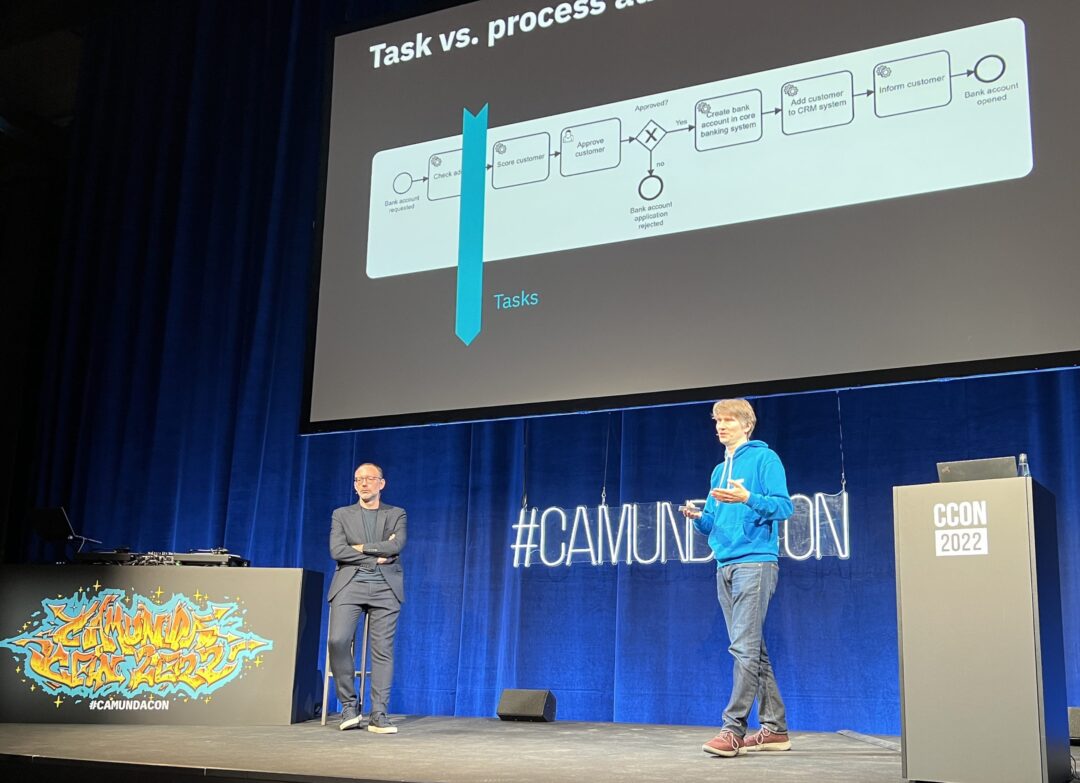CamundaCon 2022 Day 2 keynote
Blog: Column 2 - Sandy Kemsley
My little foldable keyboard isn’t playing nice, so I’m typing this directly on my iPad which is…not ideal. However, I will do my best and debug the keyboard later.
Day 2 of CamundaCon 2022 here in Berlin started off with a keynote from Bernd Ruecker, Camunda co-founder and chief technologist, and Daniel Meyer, CTO. Version 8.1 is coming up, and with it some new connectors as well as other core enhancements. Bernd started out with a reinforcement of some of Jakob Freund’s messages yesterday: the distinction between task (depth) and process (breadth) automation, and how process orchestration is characterized by endpoint diversity and process complexity. These are important points in understanding the scope of process orchestration, but also for companies like Camunda to distinguish themselves in an increasingly diverse and crowded “process automation” market.
Once Bernd had walked us through what an initial process orchestration could look like (for a bank account opening example), Daniel took over to take about moving from an initial project to a transformed, process-centric enterprise. Some of this requires tools that allow less technical developers to get involved, which means having more connectors available for these developers to create apps by assembling and configuring connectors, while more technical developers may be creating new connectors for what’s not offered out of the box by Camunda. Bernd, who loves his live demos, showed us how to create a new connector quickly in Java, then expose it graphically in the modeler using a connector template – this makes it appears as an activity type directly in the Camunda modeler. Once they are in the modeler, connectors can be used in any application, so that (for example) a connector to your bespoke mainframe monolith can be created and added to the modeler once, then used in a variety of applications.
The concept of connectors as a way for less technical developers to use a BPMN model as an application development framework isn’t new: many other BPMS vendors have been doing this for a long time. Camunda is obviously feeling the pressure to move from a purely developer-focused platform and address some level of low-code needs, and connectors is one if the main ways that they are doing this. The ease in creating new connectors is pretty cool – many products let you use their out of the box connectors but don’t make it that easy to make new ones. Camunda is positioning this capability (creating new connectors quickly) as core to automating the enterprise.
We heard about more of what they’ve been releasing this year, including the web modeler that allows new developers and business analysts to be onboarded quickly without having to install anything locally. The modeler includes BPMN validation so that correct process models are created and errors avoided before deploying to the server. They are also using FEEL (friendly enough expression language) – borrowed from the DMN specification – for scripting within tasks. This use of FEEL is also being done by other standards-focused vendors, such as Trisotech. We also saw some of the things that they’re working on, such as interactive debugging to step through processes, and an improved forms UI builder. Again, not completely new ideas in the BPM space, but nice productivity enhancements to their developer experience. Based on what they’ve seen within their own company, they’re integrating Slack and Microsoft Teams for human task orchestration to avoid the requirement for users to go to a separate app for their process task list.
Bernd addressed the issue of Camunda supporting low code, when they have been staunchly pro code only for most of their history. Fundamentally, the market (that is, their customers and prospective customers) need this capability, and it’s clear that you have to offer at least something low code (ish) to play in the process automation space these days. This is definitely a shift for them, and they are doing it fairly gracefully although are a bit behind the curve in much of the functionality because they stuck to their roots for so long. In their favour, they’re still a small and nimble company and can roll out this type of functionality in their product fairly quickly. They are mostly just dipping into the pro code end of the low code space, and it will be interesting to see how far they go in upcoming releases. Creating more low code tooling and more connectors obviously creates more long-term technical debt for Camunda: if they decide this isn’t the way forward after a while, or they change some of the underlying architecture, customers could end up with legacy versions of connectors and low code tooling that need to be updated. Definitely worth checking out for existing Camunda customers who want to accelerate adoption within their organizations.
By the way, I’ve had so much great feedback on our panel yesterday: happy to hear that we had some nuggets of wisdom in there. So many good conversations last night at the BBQ and continuing into today between sessions. I’ll post a link to the recorded session when it’s published.
Leave a Comment
You must be logged in to post a comment.








